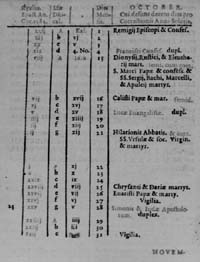Calendars and Calendar Reform
 Taken from a work published in 1582, the year of the calendar reform, days 5 to 14 October are omitted.
Taken from a work published in 1582, the year of the calendar reform, days 5 to 14 October are omitted.
Archaeological evidence, including stone circles such as Stonehenge, indicates the importance attached to periodic astronomical phenomena by prehistoric communities. The ancient Egyptians, worshippers of the sun god Ra, established a calendar year of 365 days c. 4500 BC; in Lower Egypt this was combined with months of 29/30 days based on observation of moon, and in Upper Egypt with observation of the star Sirius, whose heliacal [glossary] rising coincided with the flooding of the Nile. Later, the months were regularised to 30 days each, and five extra days completed the year. The Mesopotamians employed a luni-solar calendar; at first they determined the beginning of months by observations of the moon, but were utilising a computational method by the fifth century BC. An intercalary month was added at irregular intervals to keep the lunar calendar in line with the solar year. From about 500 BC, this was regularised according to the so-called Metonic cycle [Glossary] of 7 intercalations in 19 years. In Ancient Greece, calendars varied from city-state to city-state, but were also of the luni-solar variety.
In Ancient Rome, the correspondence between lunar and solar calendar was eroded as the officials responsible for intercalations used their powers to extend the terms of office of their friends and shorten those of their rivals. The new calendar instituted by Julius Caesar in 46 BC was therefore a much needed reform. In the Julian calendar, the link with the lunar cycle was lost - the months were of fixed lengths (initally alternating 30 and 31 days, with the exception of February) - and every fourth year was designated a leap year. This resulted in a Julian year approximately eleven minutes longer than the solar (tropical) year; or a gain of about three days per 400 years. Over time, this gain vastly exacerbated the natural movement of the equinoxes through the year due to the precession of the earth on its axis; a matter which was of particular concern to Christians because the formula for determining the date of Easter relied upon the lunar phases and the date of the vernal equinox. For several centuries, the Church paid little heed to the concerns of astronomically literate Christians who expressed concern that the Easter was being celebrated on the wrong date. Reform of the calendar was finally enacted by Pope Gregory XIII in 1582, but as a consequence of the Church Reformation of the sixteenth century, was not immediately adopted by Protestants. Advised by a congregation including the Jesuit mathematician Christoph Clavius and the Dominican mathematician and instrument-maker Egnatio Danti, the Gregorian reform involved the omission of ten days (eleven by the time Britain adopted the new calendar in 1752), and the withholding of leap-days from century-years not divisible by 400.